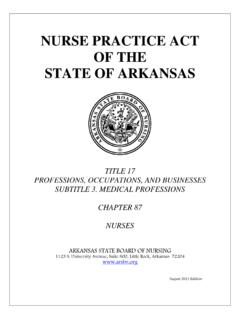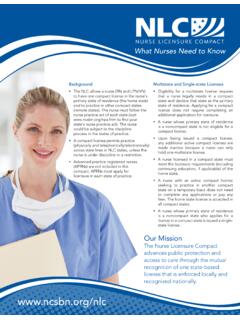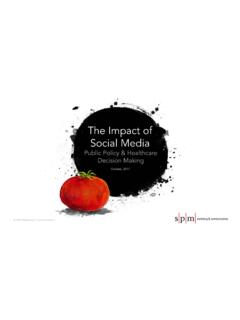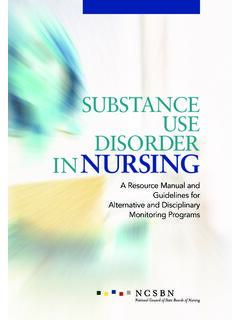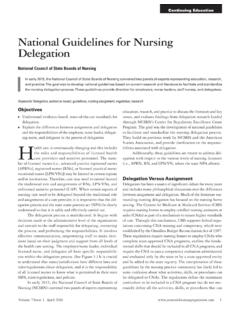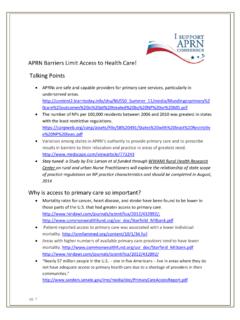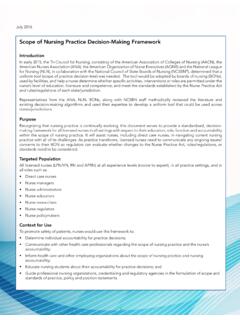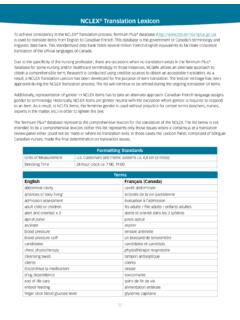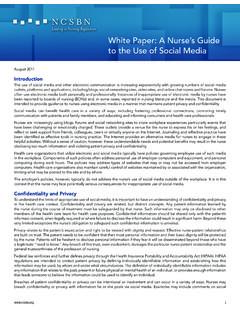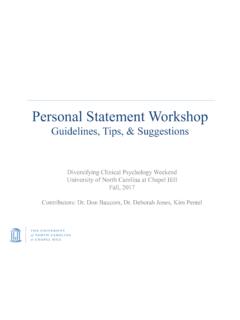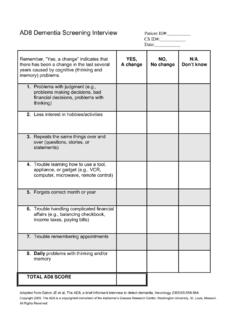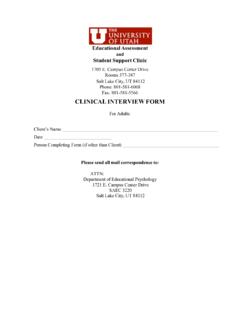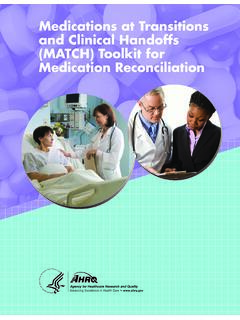Transcription of Nursing Clinical Decision Making: A Literature Review
1 1 Abstract Clinical judgment and Decision -making is a required component of professional Nursing . Expert nurses are known for their efficient and intuitive Decision -making processes, while novice nurses are known for more effortful and deliberate Decision -making processes. Despite taking longer to make decisions, novices still have trouble with effective Decision -making. The aim of this paper is to Review the factors that contribute to Clinical judgment and Decision -making of novice nurses. This was achieved by reviewing over two hundred articles produced by searches through PsycINFO. These articles used various methods of data collection, ranging from observation to well-controlled experimentation, although the majority of the studies were exploratory in nature.
2 Factors that influenced Decision -making were categorized as either individual or environmental factors. Individual factors captured elements unique to the Decision -maker and included factors such as experience, cue recognition, and hypothesis updating. By contrast, environmental factors captured elements surrounding the Decision -task. Among these factors were task complexity, time pressure, and interruptions. The reliability and robustness of these factors are discussed. Keywords: novice nurses, Clinical Decision -making, Clinical reasoning, Clinical judgment I. INTRODUCTION ound Clinical reasoning and Clinical Decision -making is largely considered a hallmark of expert Nursing (Simmons, Lanuza, Fonteyn, Hicks, & Holm, 2003). The ability to carry out competent Decision -making is a critical and fundamental aspect of professional Nursing .
3 Decision -making abilities distinguish professional nurses from ancillary health care workers (Hughes & Young, 1990). In professional health care, it is often the case that Decision consequences approach high risks, leaving little room for errors. Furthermore, the current health care environment has trended towards placing more accountability and responsibilities on nurses (Simmons Paper completed in August, 2012. This work was supported in part by the National Council of State Boards of Nursing (NCSBN). Nursing Clinical Decision -making: A Literature Review . W. J. Muntean is with the Department of Psychology, University of Oklahoma. Correspondence concerning this paper should be addressed to William J. Muntean, Department of Psychology, University of Oklahoma, Dale Hall Tower, 455 West Lindsey Street, Norman, OK 73019.)
4 E-mail: et al., 2003; Saintsing, Gibson, & Pennington, 2011; Ebright, Urden, Patterson, & Chalko, 2004; Casey, Fink, Krugman, & Propst, 2004; Hickey, 2009). Nurses are at the forefront of patient care, usually the first link in the causal chain between identifying complications and eventual rescue (Thompson et al., 2008). This, coupled with the increasing responsibilities, underscores the importance of sound Clinical reasoning and Decision -making. Choosing appropriate interventions accurately and timely is crucial (Clarke & Aiken, 2003). Brennan and colleagues estimate that up to 65% of adverse events that hospital inpatients endure may be preventable a result of poor Clinical Decision -making (Brennan et al., 2004; Leape, 2000). Hodgetts et al. (2002) report that 60% of cardiac arrests suffered by inpatients during hospitalization could have been prevented, with nearly half of those cases showing Clinical signs of deterioration recorded in the preceding 24 hours, but not acted on (as cited in Thompson et al.
5 , 2008). Shockingly, the values recorded but not acted upon are the part of the basic knowledge of Nursing practice, and are essential cues used to make Clinical decisions ( , hear rate, respiratory rate, and oxygenation; see Goldhill, 2001). Surely, nurses must be aware that the decisions they make have significant impact on the healthcare outcome of their patients, yet these reports raise major concern (Long, Young, & Shields, 2007; Dowding & Thompson, 2003). What factors contributed to such lapses in Clinical judgments? Given the nature of the profession, nurses must perform at high levels but can this be expected of novice nurses who just enter the field? A descriptive survey of employers of new nurses found that, in general, newly licensed nurses tend to be inadequately prepared to enter practice (Smith & Crawford 2002), with half the novice nurses being involved in errors of Nursing care (Saintsing et al.
6 , 2011; Smith & Crawford 2003; Kenward & Zhong 2006). In addition, Saintsing et al. (2011) reported that only 20% of employers were satisfied with Decision -making abilities of new nurses. Given the high involvement in errors and the assumption that Decision -making is an integral part of Nursing , it would prudent to carefully inspect the factors contributing to Clinical Decision -making in novice nurses. In what follows, I present a Review of the emerging themes that have been explored in Nursing Clinical Decision -making and highlight the known and suspected influencers on Clinical Decision -making. Nursing Clinical Decision -Making: A Literature Review William J. Muntean S W. J. Muntean | Clinical Decision -making 2 II. Literature Review PROCESS An evaluation of the peer-reviewed Literature generated from PsycINFO with various combinations of the terms Decision -making , judgment , Clinical , novice , and Nursing was carried out.
7 The following limits were placed on the search: (1) articles must come from peer-reviewed journals; (2) only English language publications were reviewed; and (3) full text of the article must be available. Using these criteria, the search produced an overwhelming set of articles over 1500 studies. Of these articles, roughly 800 were loosely related to Nursing Clinical Decision -making and were reviewed. This subset of articles produced about 200 articles that had strong relevance to Clinical Decision -making and were subjected to a more detailed and thorough Review . The following paper summarizes research from the final subset of articles. In addition to a database search, citations to and from articles were also used. This led to the Review of several book chapters, but to foreshadow a general theme found in the Literature , most chapters are not reported because of the highly subjective nature of the content.
8 Overall, this process uncovered three research themes on Clinical Decision -making research on factors that influence nurse participation in Clinical Decision -making, research comparing Decision -making processes between novice and expert nurses, and research on factors known (or suspected) to influence Decision -making in Nursing . The single primary objective of this Literature Review was to uncover factors that influence Clinical Decision -making (either positively or negatively) in first-year novice nurses. However, there is a dearth of studies conducted with such a specific research goal; studies either deviate on participants used or focus on other aspects of Clinical Decision -making. There are several likely reasons that research on Clinical Decision -making of novice nurses is limited.
9 First, there is a lack of consistency as to what constitutes a novice nurse (Simmons et al., 2003). Several researchers qualify Nursing students (perhaps inappropriately) as novices (Tanner, Padrick, Westfall, & Putzier, 1987; Thiele, Holloway, Murphy, & Pendarvis, 1991; Baxter & Rideout, 2006; Lofmark, Smide, & Wikblad, 2006; Shin, 1998), whereas others define it within a single year (Ebright et al., 2004; Wainwright, Shepard, Harman, & Stephens, 2011; Saintsing et al., 2011; Greenwood & King, 1995; Forneris & Peden-McAlpine, 2007) and still others define it as within two years (Hoffman, Aitken, & Duffield, 2009; Grobe, Drew, & Fonteyn, 1991). Second, a substantial number of Clinical Decision -making researchers have seemingly focused on the development of Decision -making abilities and therefore include novice nurses as a mere baseline comparison group (Chunta & Katrancha, 2010; Benner, Tanner, & Chesla, 1992).
10 Lastly, researchers focusing on the core Decision -making process are more interested in nurses whose Decision -making abilities are purportedly fully developed ( , expert nurses), which makes the implicit assumption that all novice Decision -making is inferior and unstable (Buckingham & Adams, 2000a, 2000b). Often times these studies are carried out on specialized nurses, requiring more expertise and experience than most novice nurses have (Kaasalainen et al., 2007; Marshall, West, & Aitken, 2011; Monterosso et al., 2005). Despite the dispersive focus of the field, studies that had strong implications for novice Decision -making were included and described accordingly. The three lines of research that emerged from the Review are intimately related and need to be considered collectively.
